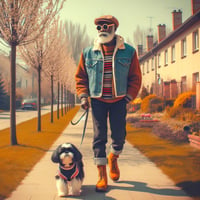Walking your dog should be a pleasant experience for both of you, but it can quickly become...
Walking Other People's Dogs: How to Be a Responsible Dog Walker
Discover essential safety tips and guidelines for being a responsible dog walker when walking other people's dogs.
Understanding the Dog's Behavior and Needs
When walking other people's dogs, it's important to understand their behavior and needs. Each dog is unique and may have different temperaments and preferences. Take the time to get to know the dog before the walk, paying attention to their body language and cues. This will help you anticipate their reactions and ensure a safe and enjoyable walk for both the dog and yourself. Additionally, be aware of any specific needs the dog may have, such as medical conditions or fears, and adapt your walking routine accordingly.
Another important aspect of understanding the dog's behavior is recognizing signs of stress or aggression. If the dog shows signs of discomfort, such as growling, barking excessively, or pulling on the leash, it's important to address the situation calmly and appropriately. Avoid putting the dog in situations that may trigger aggression or anxiety, and always prioritize their safety and well-being.
Preparing for the Walk
Before taking someone else's dog for a walk, make sure you are fully prepared. This includes gathering all necessary equipment, such as a leash, collar or harness, and poop bags. Ensure that the leash is in good condition and securely attached to the dog's collar or harness. It's also a good idea to carry some treats or rewards to reinforce positive behavior during the walk.
In addition to physical preparation, mentally prepare yourself for the walk. Familiarize yourself with the dog's walking route and any potential hazards along the way, such as busy roads or aggressive animals. Plan the duration and intensity of the walk based on the dog's age, breed, and fitness level. Taking these steps will help you provide a safe and enjoyable experience for the dog.
Practicing Proper Leash Etiquette
Proper leash etiquette is crucial when walking other people's dogs. Always keep the dog on a leash unless you are in a designated off-leash area. Use a leash that is appropriate for the dog's size and strength, ensuring that it is neither too long nor too short. Maintain a firm grip on the leash, keeping it at a length that allows the dog to walk comfortably by your side without pulling or lagging behind.
When encountering other dogs or people during the walk, be mindful of the dog's behavior and react accordingly. If the dog becomes anxious or aggressive, calmly redirect their attention and give them space. Always ask for permission before allowing the dog to interact with other dogs or people, as some dogs may not be friendly or may have specific socialization needs.
Ensuring Safety in Different Environments
As a responsible dog walker, it's important to ensure the safety of the dog in various environments. Pay attention to the weather conditions and adjust the walk accordingly. In extreme heat or cold, limit the duration of the walk and provide the dog with access to water or shelter as needed. When walking in unfamiliar areas, be cautious of potential hazards such as toxic plants, broken glass, or uneven surfaces.
If you are walking the dog at night or in low visibility conditions, make sure to use reflective gear and carry a flashlight to enhance visibility and keep both you and the dog safe. Additionally, be mindful of any local regulations or leash laws in the area and abide by them to prevent any accidents or conflicts.
Handling Unexpected Situations
Despite careful preparation and precautions, unexpected situations may arise during a dog walk. It's important to stay calm and handle these situations responsibly. If the dog becomes startled or frightened, avoid sudden movements or loud noises that may escalate their fear. Instead, try to redirect their attention to something positive or reassuring.
In the event of an encounter with an aggressive dog, never attempt to intervene physically. Instead, create distance between the dogs by calmly moving away or using objects as barriers. If necessary, seek help from local authorities or animal control.
If the dog becomes injured or shows signs of distress during the walk, prioritize their well-being by seeking immediate veterinary care or contacting the owner for guidance. Remember, the safety and health of the dog should always be your top priority.
.png?width=50&height=50&name=Profile%20round%20logo%20(1).png)



